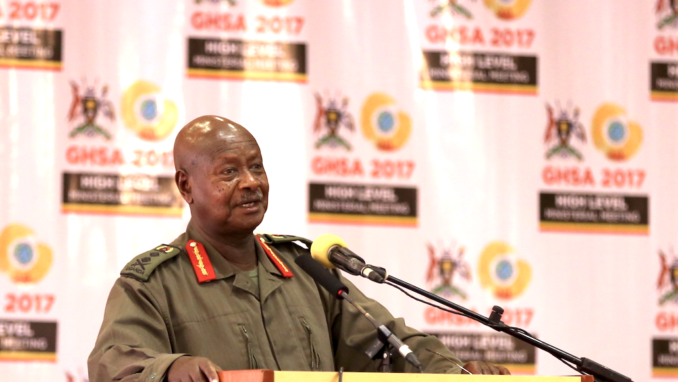The first of 12 articles, building a clearer picture of what happened and what was not reported. It has heavy relevance in this part of the world and is being watched like a hawk. Needless to say, the reality is polarised to the utopian narrative. Puffins asked for some articles on this part of the world, here’s the next batch, for those that read. Where possible pics and web links embedded but the TPTB will determine before uploading whether or not, they’re included. My thanks to those involved (usual pack drill, no names) at all levels.
Where, why and how it all began. Few capitals come greener [in the real sense] than Kampala. Like Rome, sprawling across seven hills, Uganda’s largest city nudges the equator and at this latitude, vegetation runs riot.
White explorers stumbled upon the kingdom of Buganda in the 1850s. Nestling in the hills north of what the locals called Nnalubale, which John Hanning Speke baptised Lake Victoria, Buganda was a sophisticated, centuries-old kingdom that had thrown sturdy roads and aqueducts across the surrounding territory. Ruled over by the feared Kabaka, it boasted a fleet of 230 war canoes and a 125,000-strong army, which was regularly despatched to fight its great main rival, the Bunyoro kingdom of the North West.
Like Swahili traders who had preceded them, offering guns in exchange for ivory, new arrivals left convinced this land was ripe for plucking. And took the message back to European capitals. As the Scramble for Africa got underway, Catholic White Fathers from France, supported by Germany, vied with Protestant missionaries from Britain and Muslim traders from Zanzibar for the souls of Kabaka and his subjects. A series of religious wars broke out between their converts.
The British eventually won the contest and a pact was signed with the Baganda, whose forces were then deployed to subdue the Bunyoro and Acholiland to the north, while treaties were agreed with the neighbouring kingdoms of Ankole and Busoga to the west and east.
The Imperial British East Africa Company was granted the right to run Uganda and given the task of building a 660-mile railway from Mombasa to Lake Victoria’s eastern shores, the better way to tap the interior’s wealth. It proved too much for the company and in 1894, London took over, and the protectorate of Uganda was declared.
In contrast to Kenya, a settler colony, Uganda was administered under a system of indirect rule, with the British delegating authority to Baganda officials who fanned out from the capital. They were just as high-handed and contemptuous of local ways as white outsiders, insisting the matooke food staple, way of dressing, and Luganda language being adopted.
As it edged towards independence, Uganda was a highly polarized territory, divided by language, religion and ethnicity. The main fracture line ran between the neglected North and the cotton-producing, prosperous South. The South also had its own tensions: between Baganda royalists bent on independence and non-Baganda; Democratic Party members aggrieved at their Catholic community’s second-class status and the dominant Protestant Uganda People’s Congress (UPC). When the Union Flag was lowered in 1962, independent Uganda’s course was decidedly wobbly.
In most African countries, a portrait of the president hangs in every office, shop counter, more quiet recognition of who is boss than affection.
The lobby of the main Uganda newspaper, the Monitor, boasts not one, but nine portraits marking Uganda’s presidencies: Edward Mutesa (the Kabaka), Milton Obote, General Idi Amin, Yusuf Lule, Godfrey Binaisa, Paolo Muwanga, Obote (again, but worse this time), General Bazilio Olara-Okello (only for two days), General Tito Okello, and Yoweri Museveni (known regionally as M7). The gallery is a discrete warning of just how easily things have gone wrong, for at least two of those come with associations of pure horror.
Modern Uganda has never experienced a peaceful transfer of power. Kampala’s striking feature, the marabou storks, wheeling like vampires over slums and prosperous neighbourhoods were once attributed to the human carrion left littering the streets by rival militias vying for control of the seven hills. Those memories have a long reach.
Taking oath of office on 29th January 1986, Bible in hand and a bewigged white Chief Justice by his side, M7 promised to end all that: “Nobody is to think that what has been happening in the last few days is a mere change of guard…. This is a fundamental change in the politics of our government.”

Ugandan President Yoweri Museveni,
CDC Global – Licence CC BY-SA 2.0
Flanked by fighters of his National Resistance Army (NRA), M7 still spoke with a Western Ugandan accent that labelled him as a Munyankole “country bumpkin” in the eyes of Baganda aristocracy.
After violent brawls in Ugandan parliament, the age limit preventing him from running for another election was scrapped in 2017, paving the way for his own Presidency for life. Impatience among millennials who have never known any other president is rising, as the violence in the run-up to the 2021 elections demonstrated. The former school teacher always knew his rebel group was destined to be more than a forgettable garble of initials. The National Resistance Movement (NRM) saw its mandate as exporting change across the continent, it has done that, but not in the way originally envisaged. M7 achieved that ambition thanks to the special bond he forged with one beleaguered ethnic community in particular, the one into which Paul Kagame (and others) was born.
© AW Kamau 2023



